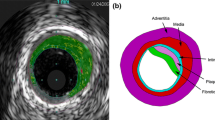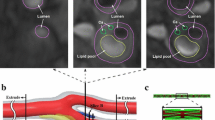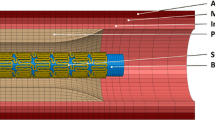Abstract
The stresses induced on plaque wall during stent implantation inside a stenotic artery are associated with plaque rupture. The stresses in the plaque–artery–stent structure appear to be distinctly different for different plaque types in terms of both distribution and magnitude. In this study, a nonlinear finite element simulation was executed to analyze the influence of plaque composition (calcified, cellular, and hypocellular) on plaque, artery layers (intima, media, and adventitia), and stent stresses during implantation of a balloon expandable coronary stent into a stenosed artery. The atherosclerotic artery was assumed to consist of a plaque and normal arterial tissues on its outer side. The results revealed a significant influence of plaque types on the maximum stresses induced within plaque wall and artery layers during stenting, but not when calculating maximum stress on stent. The stress on stiffer calcified plaque wall was in the fracture level (2.21 MPa), whereas cellular and hypocellular plaques play a protective role by displaying less stress on their wall. The highest von Mises stresses were observed on less stiff media layer. The findings of this study suggest a lower risk of arterial vascular injury for calcified plaque, while higher risk of plaque ruptures for cellular and hypocellular plaques.







Similar content being viewed by others
References
Chua S, Mac Donald B, Hashmi M (2002) Finite-element simulation of stent expansion. J Mater Process Technol 120:335–340
Colombo A, Stankovic G, Moses JW (2002) Selection of coronary stents. J Am Coll Cardiol 40:1021–1033. doi:10.1016/S0735-1097(02)02123-X
David Chua SN, Mac Donald BJ, Hashmi MSJ (2003) Finite element simulation of stent and balloon interaction. J Mater Process Technol 143–144:591–597. doi:10.1016/S0924-0136(03)00435-7
de Weert TT, Ouhlous M, Zondervan PE, Hendriks JM, Dippel DW, van Sambeek MR, van der Lugt A (2005) In vitro characterization of atherosclerotic carotid plaque with multidetector computed tomography and histopathological correlation. Eur Radiol 15:1906–1914
Faghihi S, Gheysour M, Karimi A, Salarian R (2014) Fabrication and mechanical characterization of graphene oxide-reinforced poly (acrylic acid)/gelatin composite hydrogels. J Appl Phys 115(8):083513. doi:10.1063/1.4864153
Faghihi S, Karimi A, Jamadi M, Imani R, Salarian R (2014) Graphene oxide/poly(acrylic acid)/gelatin nanocomposite hydrogel: experimental and numerical validation of hyperelastic model. Mater Sci Eng, C 38:299–305. doi:10.1016/j.msec.2014.02.015
Faturechi R, Karimi A, Hashemi A, Navidbakhsh M (2014) Mechanical characterization of peritoneum/fascia under uniaxial loading. J Biomater Tissue Eng 4:189–193. doi:10.1166/jbt.2014.1156
Halabian M, Karimi A, Barati E, Navidbakhsh M (2014) Numerical evaluation of stenosis location effects on hemodynamics and shear stress through curved artery. J Biomater Tissue Eng. doi:10.1166/jbt.2014.1176
Hamilton AJ, Kim H, Nagaraj A, Mun J-H, Yan LL, Roth SI, McPherson DD, Chandran KB (2005) Regional material property alterations in porcine femoral arteries with atheroma development. J Biomech 38:2354–2364. doi:10.1016/j.jbiomech.2004.10.018
Holzapfel GA, Sommer G, Gasser CT, Regitnig P (2005) Determination of layer-specific mechanical properties of human coronary arteries with nonatherosclerotic intimal thickening and related constitutive modeling. Am J Physiol Heart Circ Physiol 289:H2048–H2058
Holzapfel GA, Sommer G, Regitnig P (2004) Anisotropic mechanical properties of tissue components in human atherosclerotic plaques. Trans ASME-K-J Biomech Eng 126:657–665. doi:10.1115/1.1800557
Holzapfel GA, Stadler M, Gasser TC (2005) Changes in the mechanical environment of stenotic arteries during interaction with stents: computational assessment of parametric stent designs. Trans ASME-K-J Biomech Eng 127:166–180. doi:10.1115/1.1835362
Karimi A, Faturechi R, Navidbakhsh M, Hashemi A (2014) A nonlinear hyperelastic behavior to identify the mechanical properties of rat skin under uniaxial loading. J Mech Med Biol 14:1450075. doi:10.1142/S0219519414500754
Karimi A, Navidbakhsh M (2013) Measurement of the nonlinear mechanical properties of PVA sponge under longitudinal and circumferential loading. J Appl Polym Sci 131:40257. doi:10.1002/APP.40257
Karimi A, Navidbakhsh M, Haghpanahi M (2014) Constitutive model for numerical analysis of polyvinyl alcohol sponge under different strain rates. J Thermoplast Compos Mater. doi:10.1177/0892705713520176
Karimi A, Navidbakhsh M (2014) An experimental study on the mechanical properties of rat brain tissue using different stress-strain definitions. J Mater Sci Mater Med. doi:10.1007/s10856-014-5198-0
Karimi A, Navidbakhsh M, Yousefi H (2014) Mechanical properties of polyvinyl alcohol sponge under different strain rates. Int J Mater Res 105:404–408. doi:10.3139/146.111036
Karimi A, Navidbakhsh M (2014) Mechanical properties of PVA material for tissue engineering applications. Mater Tech Adv Perform Mater 29:90–100. doi:10.1179/1753555713Y.0000000115
Karimi A, Navidbakhsh M, Alizadeh M, Razaghi R (2014b) A comparative study on the elastic modulus of polyvinyl alcohol sponge using different stress-strain definitions. Biomed Eng. doi:10.1515/bmt-2013-0110
Karimi A, Navidbakhsh M, Alizadeh M, Shojaei A (2014) A comparative study on the mechanical properties of the umbilical vein and umbilical artery under uniaxial loading. Artery Res. doi:10.1016/j.artres.2014.02.001
Karimi A, Navidbakhsh M, Beigzadeh B (2014) A visco-hyperelastic constitutive approach for modeling polyvinyl alcohol sponge. Tissue Cell 46:97–102. doi:10.1016/j.tice.2013.12.004
Karimi A, Navidbakhsh M, Beigzadeh B, Faghihi S (2013) Hyperelastic mechanical behavior of rat brain infected by Plasmodium berghei ANKA-experimental testing and constitutive modeling. Int J Damage Mech. doi:10.1177/1056789513514072
Karimi A, Navidbakhsh M, Faghihi S (2014) A comparative study on plaque vulnerability using constitutive equations. Perfusion 29:179–184. doi:10.1177/0267659113502835
Karimi A, Navidbakhsh M, Faghihi S (2014) Fabrication and mechanical characterization of polyvinyl alcohol sponge for tissue engineering applications. Perfusion 29:232–238. doi:10.1177/0267659113513823
Karimi A, Navidbakhsh M, Faghihi S (2014) Measurement of the mechanical failure of PVA sponge using biaxial puncture test. J Biomater Tissue Eng 4:46–50. doi:10.1166/jbt.2014.1134
Karimi A, Navidbakhsh M, Faghihi S, Shojaei A, Hassani K (2013) A finite element investigation on plaque vulnerability in realistic healthy and atherosclerotic human coronary arteries. Proc Inst Mech Eng H 227:148–161. doi:10.1177/0954411912461239
Karimi A, Navidbakhsh M, Motevalli Haghi A, Faghihi S (2013) Measurement of the uniaxial mechanical properties of rat brains infected by Plasmodium berghei ANKA. Proc Inst Mech Eng H 227:609–614. doi:10.1177/0954411913476779
Karimi A, Navidbakhsh M, Razaghi R (2014) Dynamic finite element simulation of the human head damage mechanics protected by polyvinyl alcohol sponge. Int J Damage Mech. doi:10.1177/1056789514535945
Karimi A, Navidbakhsh M, Razaghi R (2014) An experimental-finite element analysis on the kinetic energy absorption capacity of polyvinyl alcohol sponge. Mater Sci Eng, C 39:253–258. doi:10.1016/j.msec.2014.03.009
Karimi A, Navidbakhsh M, Razaghi R, Haghpanahi M (2014) A computational fluid-structure interaction model for plaque vulnerability assessment in atherosclerotic human coronary arteries. J Appl Phys 115:144702. doi:10.1063/1.4870945
Karimi A, Navidbakhsh M, Rezaee T, Hassani K (2014) Measurement of the circumferential mechanical properties of the umbilical vein: experimental and numerical analyses. Comput Methods Biomech Biomed Engin. doi:10.1080/10255842.2014.910513
Karimi A, Navidbakhsh M, Shojaei A, Faghihi S (2013) Measurement of the uniaxial mechanical properties of healthy and atherosclerotic human coronary arteries. Mater Sci Eng, C 33:2550–2554. doi:10.1016/j.msec.2013.02.016
Karimi A, Navidbakhsh M, Shojaei A, Hassani K, Faghihi S (2014) Study of plaque vulnerability in coronary artery using Mooney-Rivlin model: a combination of finite element and experimental method. Biomed Eng: Appl Basis Commun 26:145–152. doi:10.4015/S1016237214500136
Karimi A, Navidbakhsh M, Yamada H, Rezaee T, Hassani K (2014m) A comparative study on the quasilinear viscoelastic mechanical properties of umbilical artery and umbilical vein. Perfusion. doi:10.1177/0267659114536761
Karimi A, Navidbakhsh M, Yousefi H, Alizadeh M (2014) An experimental study on the elastic modulus of gelatin hydrogel using different stress-strain definitions. J Thermoplast Compos Mater. doi:10.1177/0892705714533377
Karimi A, Navidbakhsh M, Yousefi H, Motevalli Haghi A, Adnani Sadati SJ (2014) Experimental and numerical study on the mechanical behavior of rat brain tissue. Perfusion. doi:10.1177/0267659114522088
Lally C, Dolan F, Prendergast P (2005) Cardiovascular stent design and vessel stresses: a finite element analysis. J Biomech 38:1574–1581. doi:10.1016/j.jbiomech.2004.07.022
Lally C, Reid A, Prendergast P (2004) Elastic behavior of porcine coronary artery tissue under uniaxial and equibiaxial tension. Annals Biomed Eng 32:1355–1364
LaMuraglia GM, Southern JF, Fuster V, Kantor HL (1996) Magnetic resonance images lipid, fibrous, calcified, hemorrhagic, and thrombotic components of human atherosclerosis in vivo. Circulation 94:932–938. doi:10.1161/01.CIR.94.5.932
Lee RT, Grodzinsky AJ, Frank EH, Kamm RD, Schoen FJ (1991) Structure-dependent dynamic mechanical behavior of fibrous caps from human atherosclerotic plaques. Circulation 83:1764–1770. doi:10.1161/01.CIR.83.5.1764
Li Z-Y, Howarth S, Trivedi RA (2006) Stress analysis of carotid plaque rupture based on in vivo high resolution MRI. J Biomech 39:2611–2622. doi:10.1016/j.jbiomech.2005.08.022
Liang D, Yang D, Qi M, Wang W (2005) Finite element analysis of the implantation of a balloon-expandable stent in a stenosed artery. Int J Cardiol 104:314–318
Loree HM, Grodzinsky AJ, Park SY, Gibson LJ, Lee RT (1994) Static circumferential tangential modulus of human atherosclerotic tissue. J Biomech 27:195–204
Martin AJ, Gotlieb AI, Henkelman RM (1995) High-resolution MR imaging of human arteries. J Magn Reson Imag 5:93–100. doi:10.1161/01.CIR.0000087480.94275.97
Naghavi M, Libby P, Falk E, Casscells SW, Litovsky S, Rumberger J, Badimon JJ, Stefanadis C, Moreno P, Pasterkamp G (2003) From vulnerable plaque to vulnerable patient a call for new definitions and risk assessment strategies: part I. Circulation 108:1664–1672
Nair A, Kuban BD, Tuzcu EM, Schoenhagen P, Nissen SE, Vince DG (2002) Coronary plaque classification with intravascular ultrasound radiofrequency data analysis. Circulation 106:2200–2206. doi:10.1161/01.CIR.0000035654.18341.5E
Ogden RW (1997) Non-linear elastic deformations. Dover, New York
Ohayon J, Teppaz P, Finet G, Rioufol G (2001) In-vivo prediction of human coronary plaque rupture location using intravascular ultrasound and the finite element method. Coron Artery Dis 12:655–663
Palmaz JC (1992) Intravascular stenting: from basic research to clinical application. Cardiovasc Intervent Radiol 15:279–284
Pericevic I, Lally C, Toner D, Kelly DJ (2009) The influence of plaque composition on underlying arterial wall stress during stent expansion: the case for lesion-specific stents. Med Eng Phys 31:428–433. doi:10.1016/j.medengphy.2008.11.005
Salunke N, Topoleski L, Humphrey J, Mergner W (2001) Compressive stress-relaxation of human atherosclerotic plaque. J Biomed Mater Res 55:236–241. doi:10.1002/1097-4636(200105)55
Topoleski L, Salunke N, Humphrey J, Mergner W (1997) Composition-and history-dependent radial compressive behavior of human atherosclerotic plaque. J Biomed Mater Res 35:117–127. doi:10.1002/(SICI)1097-4636(199704)35
Wang W-Q, Liang D-K, Yang D-Z, Qi M (2006) Analysis of the transient expansion behavior and design optimization of coronary stents by finite element method. J Biomech 39:21–32. doi:10.1016/j.jbiomech.2004.11.003
Wu W, Wang W-Q, Yang D-Z, Qi M (2007) Stent expansion in curved vessel and their interactions: a finite element analysis. J Biomech 40:2580–2585. doi:10.1016/j.jbiomech.2006.11.009
Zahedmanesh H, Lally C (2009) Determination of the influence of stent strut thickness using the finite element method: implications for vascular injury and in-stent restenosis. Med Biol Eng Comput 47:385–393. doi:10.1007/s11517-009-0432-5
Acknowledgments
The authors acknowledge the Iran University of Science and Technology for funding this project.
Conflict of interest
The authors declare that they have no conflicts of interest.
Author information
Authors and Affiliations
Corresponding author
Rights and permissions
About this article
Cite this article
Karimi, A., Navidbakhsh, M., Yamada, H. et al. A nonlinear finite element simulation of balloon expandable stent for assessment of plaque vulnerability inside a stenotic artery. Med Biol Eng Comput 52, 589–599 (2014). https://doi.org/10.1007/s11517-014-1163-9
Received:
Accepted:
Published:
Issue Date:
DOI: https://doi.org/10.1007/s11517-014-1163-9




